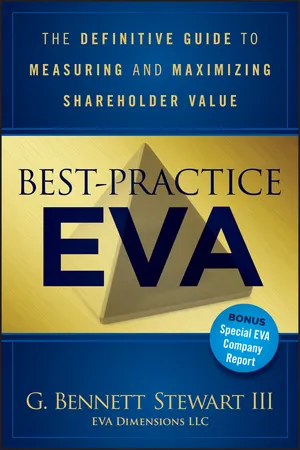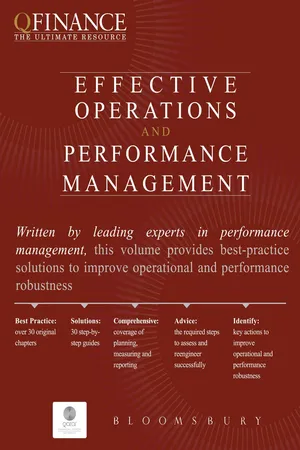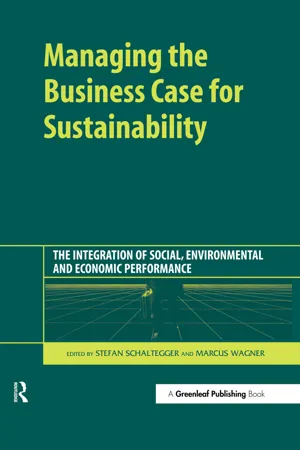Business
Economic Value Added
Economic Value Added (EVA) is a measure of a company's financial performance that calculates the difference between its net operating profit after taxes and the cost of capital. It is used to assess how effectively a company is utilizing its capital to generate profits. EVA is considered a more comprehensive measure of performance than traditional accounting metrics like net income.
Written by Perlego with AI-assistance
Related key terms
1 of 5
12 Key excerpts on "Economic Value Added"
- No longer available |Learn more
Investment Valuation
Tools and Techniques for Determining the Value of Any Asset
- Aswath Damodaran(Author)
- 2012(Publication Date)
- Wiley(Publisher)
It also looks at the conditions under which firms using these approaches to judge performance and evaluate managers may end up making decisions that destroy value rather than create it. Economic Value Added The Economic Value Added (EVA) is a measure of the dollar surplus value created by an investment or a portfolio of investments. It is computed as the product of the excess return made on an investment or investments and the capital invested in that investment or investments. This section begins by looking at the measurement of Economic Value Added, then considers its links to discounted cash flow valuation, and closes with a discussion of its limitations as a value enhancement tool. Calculating EVA The definition of EVA outlines three basic inputs we need for its computation—the return on capital earned on investments, the cost of capital for those investments, and the capital invested in them. In measuring each of these, we will make many of the same adjustments that were discussed in the context of discounted cash flow valuation. How much capital is there invested in existing assets? One obvious answer is to use the market value of the firm, but market value includes capital invested not just in assets in place but in expected future growth. 1 Since we want to evaluate the quality of assets in place, we need a measure of the capital invested in just these assets. Given the difficulty of estimating the value of assets in place, it is not surprising that we turn to the book value of capital as a proxy for the capital invested in assets in place. The book value, however, is a number that reflects not just the accounting choices made in the current period, but also accounting decisions made over time on how to depreciate assets, value inventory, and deal with acquisitions - eBook - ePub
- William R. Lalli(Author)
- 2011(Publication Date)
- Wiley(Publisher)
EVA is truly a system of measurement. It supplements traditional accounting measures of performance, giving us additional insight into our business and helping us to identify the factors that affect our performance. We have made it the centerpiece of our “value-based planning” process. And we are linking a portion of our managers’ incentive compensation to performance against EVA targets in 1993.Moreover, EVA has the important facility of connecting forward-looking valuation to performance evaluation (via actual operating performance) over discrete periods. EVA thereby enables consistent tracking of valuation. However, first, we need to explore in more depth the relationship between the two measures, EVA and shareholder value.COMPLEMENTARY MEASURES OF VALUATION Economic Value Added and ValuationThe term “shareholder value” was defined as the multiperiod, long-term valuation of a company (as of a point in time), whereas we have just seen that EVA measures value added to a shareholder’s investment for a period (e.g., a year or quarter).To determine the economic value of an enterprise, operating unit, or project requires a valuation—or all-period analysis—of all future cash flows. Generally, the entity value is the future expected cash flows discounted at a rate (or cost of capital) that reflects the riskiness of the operating cash flow. In particular: - eBook - PDF
- Stephen L. Nelson(Author)
- 2021(Publication Date)
- For Dummies(Publisher)
In that chapter, I describe how to prepare QuickBooks financial statements, including income statements (also known as profit and loss statements ) and balance sheets. Economic Value Added Analysis CHAPTER 2 Economic Value Added Analysis 381 Essentially, EVA includes a charge for the capital that you’ve invested in a busi -ness. To see whether you’re making money, you deduct this charge from your net income. A positive EVA amount indicates that your business truly produces an economic profit; in other words, a positive EVA amount indicates that even after TABLE 2-1 A Simple Income Statement Sales revenue $150,000 Less: Cost of goods sold 30,000 Gross margin $120,000 Operating expenses Rent $5,000 Wages 50,000 Supplies 5,000 Total operating expenses 60,000 Operating income 60,000 Interest expense (10,000) Net income $50,000 TABLE 2-2 A Simple Balance Sheet Assets Cash $25,000 Inventory 25,000 Current assets $50,000 Fixed assets (net) 270,000 Total assets $320,000 Liabilities Accounts payable $20,000 Loan payable 100,000 Owner’s equity S. Nelson, capital $200,000 Total liabilities and owner’s equity $320,000 382 BOOK 5 Financial Management your firm pays wages to employees, interest to lenders, and a return to sharehold -ers, some money is left over. This leftover money is the economic profit. The capital charge equals the cost of the capital (specified as an interest rate or annual return percentage) multiplied by the capital invested in the business period. The capital invested in your business equals, essentially, your owner’s equity. The cost of capital return percentage equals the return that you could earn in a similarly risky investment in something else. An example of EVA From the example data in Tables 2-1 and 2-2, calculate each of these amounts by following these steps: 1. Calculate the capital charge. For the sake of illustration, suppose that you earn a 20 percent return on the money that you’ve invested in the business described in Tables 2-1 and 2-2. - eBook - ePub
Best-Practice EVA
The Definitive Guide to Measuring and Maximizing Shareholder Value
- Bennett Stewart(Author)
- 2013(Publication Date)
- Wiley(Publisher)
CHAPTER 2 EVA and ValueHow does EVA determine a company’s share price? Not directly. It is not, after all, a per share measure. But EVA is the best measure of all to compute share prices and to explain actual stock price performance. If that were not true, there would be no case for EVA.EVA ties to share prices indirectly through a sister measure that I call MVA, standing for market value added. As it turns out, MVA is far more significant than stock price itself. Here’s why. MVA is the dollar difference between the total cash that investors have put or left in a business, and which now stands on its balance sheet as its invested capital, and the present value of the cash that they can expect to take out of the business, as indicated by the firm’s share price. For example, if a company has a total market value or enterprise value of $1 billion, and has invested $600 million of capital in net business assets, then it has created MVA of $400 million, the difference.As I said, this is a really important measure. It shows, first, how much wealth the firm has created for its owners by comparing what they have put in with what they can get out. Put another way, MVA is franchise value , the value of the business above just putting the assets in a pile. It is also, mathematically, the market’s assessment of the net present value (NPV) of all investments the company has made, those already in place plus those expected to materialize down the road. Put it all together, and MVA is more important than share price.In fact, increasing MVA should be every company’s most important financial goal . An increase in MVA reveals, as no other measure can, how successful management had been at allocating, managing, and redeploying scarce resources of all kinds so as to maximize the wealth of the owners by maximizing the net present value of the enterprise. That being the case, every board and top team should track it.As mentioned, EVA ties to share prices through its link to MVA. How important is that? It is all-important . That’s because EVA is the only performance measure that directly ties to MVA. The link between MVA and EVA exists because EVA also is the only measure that ties to NPV—to net present value. I call this the fundamental principle of wealth creation, and it states: The present value of a forecast for EVA is always mathematically identical to the net present value of discounted cash flow, or to what is the same thing, MVA at the corporate level - Pablo Fernandez(Author)
- 2002(Publication Date)
- Academic Press(Publisher)
It makes no sense to say that this ®rm does worse in year 1 EVA 362) than in year 5 EVA 438). In this example, in which earnings and Ke are constant in 19 A similar argument can be made for EP and CVA. 20 However, one can read in Stern Stewart & Co's brochure: ``EVA is the only measure that gives the right answer. All the othersÐincluding operating income, earnings growth, ROE and ROAÐ may be erroneous.'' In 2001, the message has been toned down and now says: ``Economic Value Added is the ®nancial performance measure that comes closer than any other to capturing the true economic pro®t of an enterprise.'' In a communique  issued in February 1998 by Monsanto's management to its employees, one can read: ``The larger the EVA, the more wealth we have created for our shareholders.'' Chapter 13 Shareholder Value Creation 273 every year, EVA grows from negative to positive) because the shares' book value decreases as the ®xed assets are depreciated. More recently, in a 1997 circular, Stern Stewart & Co. says: ``what matters is the growth of EVA . . . it is always good to increase the EVA.'' In our example, the EVA increases each year, but this does not mean that the company is doing better. The Boston Consulting Group does recognize the limitations of these parameters. One can read in its advertising that ``a major failure of EVA and CVA is that they ignore the cash ¯ows produced by the business.'' 13.6. USEFULNESS OF EVA, EP, AND CVA We have seen that, although the present value of EVA, EP, and CVA corresponds to MVA, it makes no sense to give EVA, EP, or CVA the meaning of value creation in each period. However, for many companies, EVA, EP, or CVA are more appropriate than the book pro®t for assessing the performance of executives or business units . It is obvious that the advantage of EVA, EP, and CVA over earnings is that they take into account the capital employed to obtain these earnings and also this capital's risk which determines its required return).- No longer available |Learn more
- Stephen L. Nelson(Author)
- 2019(Publication Date)
- For Dummies(Publisher)
This second example shows why the more complicated EVA formula can be useful. The example recognizes more explicitly how EVA results when a firm produces income in excess of the capital charges.Presenting Two Final Pointers
I want to share two final pointers with business owners who may want to use EVA analysis to think about the economics of their businesses. (My first point is pretty basic, but I think it’s probably the most important thing to take away from this chapter.)-
EVA analysis is most useful to business owners and managers — or at least to owners and managers of small and medium-size firms — as a thinking tool. In other words, even if you don’t scratch out the numbers on the back of an envelope, EVA makes sense as a way to think about how you should run your business and whether it makes sense to make changes. Comparing your firm’s net income with the amount that you could earn by selling and then reinvesting the capital elsewhere is a useful concept.I have a literary-agent friend who likes to say, “Listen to the universe.” I think that his suggestion, especially as it relates to the economics of running a business, is pretty darn good. You should listen to the economy when you think about your business, and EVA provides a tool for you to do that. For a business to make sense, it needs to return a fair share to each of its stakeholders: wages to employees; interest and debt service payments to lenders; a return to shareholders who invested capital; and then, as a practical matter, a little something left over for you, the owner. Indeed, for a business to make sense, it needs to pay more than just its capital charge.
-
Although you can use EVA analysis to evaluate a business in its entirety, EVA analysis isn’t limited to that application. You can use EVA analysis, with a little bit of fiddle-faddling, to evaluate a business unit, a particular product line, your managers, and so forth.This is really neat if you think about it. You can use EVA analysis to break your business into different profit activities. By using EVA analysis to look at the economic profit of these different profit activities, you can probably find those activities that should be emphasized because they produce an economic profit, and you can identify those activities that should be discontinued (perhaps) because they don’t produce an economic profit. You can evaluate customers and managers the same way.
- eBook - ePub
- Stephen L. Nelson(Author)
- 2016(Publication Date)
- For Dummies(Publisher)
Table 2-2 shows a simple balance sheet. These two financial statements provide much — and maybe most — of the information that you need to perform EVA analysis for your business. In fact, just go ahead and suppose that these two financial statements describe your business.TABLE 2-1 A Simple Income StatementSales revenue $150,000 Less: Cost of goods sold 30,000 Gross margin $120,000 Operating expensesRent 5,000 Wages 50,000 Supplies 5,000 Total operating expenses 60,000 Operating income 60,000 Interest expense (10,000) Net income $50,000 TABLE 2-2 A Simple Balance SheetAssetsCash $25,000 Inventory 25,000 Current assets $50,000 Fixed assets (net) 270,000 Total assets $320,000 Liabilities Accounts payable $20,000 Loan payable 100,000 Owner’s equity S. Nelson, capital 200,000 Total liabilities and owner’s equity $320,000 If you’re uncomfortable interpreting either income statements or balance sheet financial statements, you may want to review the material covered in Book 1, Chapter 1 . In that chapter, I describe how financial statements work.If you’re not sure how to produce a financial statement by using QuickBooks, refer to Book 4, Chapter 2 . In that chapter, I describe how to prepare QuickBooks financial statements, including income statements (also known as profit and loss statements ) and balance sheets.Essentially, EVA includes a charge for the capital that you’ve invested in a business. To see whether you’re actually making money, you deduct this charge from your net income. A positive EVA amount indicates that your business truly produces an economic profit; in other words, a positive EVA amount indicates that even after your firm pays wages to employees, interest to lenders, and a return to shareholders, some money is left over. This leftover money is the economic profit.The capital charge equals the cost of the capital (specified as an interest rate or annual return percentage) multiplied by the capital invested in the business period. The capital invested in your business equals, essentially, your owner’s equity. The cost of capital return percentage equals the return that you could earn in a similarly risky investment in something else. - Bloomsbury Publishing(Author)
- 2010(Publication Date)
- Bloomsbury Information(Publisher)
however, a robust system that’s adhered to in times of boom and bust will provide the foun-dation of sound decision-making and business practices. and to management choice and opportunity that allow managers to bet their own success on their meeting or beating stockholder requirements. cONcluSION eVa is, in short, the best measurement tool for creating stockholder value. a balanced score-card of metrics allows for a big-picture view, but what is the balancing mechanism? If value creation over the long term is the goal (and if it isn’t, stockholders should run), then eVa must be the balancing mechanism. Sales, margin, operating profit, and bottom-line profit simply fall short. Market value lacks levers. retu rn measures give the wrong answers. Only eVa can change companies. MOre INfO Books: Bloxham, Eleanor. Economic Value Management: Applications and Techniques . Hoboken, NJ: Wiley, 2003. Stern, Joel M., and John S. Shiely. The EVA Challenge: Implementing Value-Added Change in an Organization . New York: Wiley, 2004. Young, David, and Stephen F. O’Byrne. EVA and Value-Based Management: A Practical Guide to Implementation . New York: McGraw-Hill, 2000. Website: A site set up by Stern Stewart & Co., the global consulting company which pioneered the develop-ment of the EVA framework: www.sternstewart.com MaKING IT haPPeN • Start using EVA as the key financial measure: subtract input (annual rental charge on the total capital employed) from output (adjusted operating profit after tax). • Employ EVA as the foundation of a more transparent, responsible, and accountable management system, with robust control and performance evaluation. • With the right to make decisions accurately allocated, put a fair EVA-based system of transfer pricing in place. • Couple continuous restructuring of existing businesses to milk value with cautious investment in future businesses.- eBook - ePub
- Ruth Bender(Author)
- 2013(Publication Date)
- Routledge(Publisher)
Chapter 16 ).Unlike the two metrics discussed below, SVA can be difficult to use as a one-period tool. Positive free cash flow in a period is not necessarily good; negative free cash flow might not be bad. The metric is mainly used for valuation and planning rather than as a periodic measure of performance.Economic profit
Economic profit (sometimes known as ‘residual income’) is a generic name that covers many of the different variants of profit-based measures of shareholder value. This is the surplus earned by a business in a period after deducting all expenses including the cost of capital. It can be calculated in two ways, as shown in Working Insight 1.5 .Working Insight 1.5Calculation of economic profitTherefore, the Return on Investment is 2,400 ÷ 20,000 = 12%Operating profit after tax £2,400 Capital employed £20,000 Cost of capital 10% Calculation 2 Economic profit = Capital employed × Spread Spread = Return on Investment less Cost of Capital Economic profit = 20,000 × (12% – 10%) = £400 Calculation 1 Operating profit after tax 2,400 less: cost of capital (20,000 @ 10%) 2,000 Economic profit £400 Economic profit (EP) is primarily used for performance measurement. It has the advantage that it teaches managers a great respect for capital – it is no longer seen as ‘free’ – and encourages them to run their businesses so as to minimize capital employed.8 In many instances this behavioural change is beneficial to the business, although some would argue that EP is a single-period measure, and taking it to extremes can lead to capital-starved businesses, limiting growth, and reducing the utility of other stakeholders.8 - eBook - ePub
Managing the Business Case for Sustainability
The Integration of Social, Environmental and Economic Performance
- Stefan Schaltegger, Marcus Wagner, Stefan Schaltegger, Marcus Wagner(Authors)
- 2017(Publication Date)
- Routledge(Publisher)
2 ). Therefore, this chapter introduces the concept of Environmental Value Added (Figge 2001)—a concept that expresses the eco-efficiency of a company in comparison with a benchmark in absolute monetary terms.The notion of efficiency is not new in economics. Efficiency considerations are used whenever desired and undesired aspects need to be balanced. A good example is risk–return considerations in financial management. It is usually assumed that investors like return and dislike risk. When they decide where to invest, investors therefore take two aspects into account—risk and return. There are a number of ratios that are used to describe the relation of risk to return. The best known ratios are those proposed by Sharpe (1966), Jensen (1968) and Treynor (1965).There are a number of difficulties associated with the use of risk return ratios. In response to these difficulties, Modigliani and Modigliani (1997) proposed a new risk–return measure. This new measure expresses the relation between risk and return in a monetary unit and thus facilitates its interpretation. As shown by Figge (2001), eco-efficiency can be measured in a similar way.Environmental Value Added corresponds to the economic value that is created by a level of eco-efficiency above the benchmark level. Environmental Value Added measures are therefore analogous to Economic Value Added (Stewart 1991)—the economic value of an eco-sur-efficiency.The Environmental Value Added concept is easy to depict graphically (Figure 1 ). The slopes of the two lines through points A and B reflect the eco-efficiency of the company (line through point A) and the benchmark (point B). The steeper the slope the more value is created per environmental impact added. Therefore, a steeper slope reflects a higher level of eco-efficiency. In the example depicted in Figure 1 - eBook - PDF
The EVA Challenge
Implementing Value-Added Change in an Organization
- Joel M. Stern, John S. Shiely, Irwin Ross(Authors)
- 2002(Publication Date)
- Wiley(Publisher)
SM&A 154 1,074 3,529 7,488 Amortization of Cap. R&D 193 780 2,399 5,986 Net Operating Profit 656 6,482 14,303 29,134 EVA 639 6,336 12,672 25,797 Percent of Sales 35% 45% 39% 40% EVA and the “New Economy” 215 and other long-term investments. EVA for RealNetworks, Inc. is, in fact, quite strong. It averaged 40 percent of revenue for the four-year period and rose to 44 percent in 1999. There do not seem to be many Old World companies that can deliver EVA after capital charges of this magnitude. To dig deeper into the matter, value is driven both by perfor- mance today and by developing the core competency and competi- tive position to deliver value in the future. We can see this if we further develop our EVA valuation equation into two components, as shown in Figure E.2. The first is simply the present value of EVA if we assume the current EVA is repeated forever. This is calculated as the current EVA divided by the cost of capital. When this is added to the capital base, we see what the company would be worth if the market thought current performance would perpetuate. We call this the Current Operations Value (COV). The second is the present value of expected improvements in EVA from this point for- ward. We call this the Future Growth Value (FGV). Where the FGV is a substantial percentage of the total enter- prise value of a company, we should consider the components of FGV. Despite the strong EVA trends, virtually all new economy companies have the majority of current value in FGV. There are three primary sources of FGV: 1. The expected growth in performance from currently mar- keted products. 2. The expected contribution of products in development that are just being released. 3. The benefit of products that the company has not even identi- fied yet—the value investors are willing to assign to a com- pany to recognize that there is some probability that a successful team will still come up with new ideas far out into the future. - No longer available |Learn more
- (Author)
- 2014(Publication Date)
- Orange Apple(Publisher)
____________________ WORLD TECHNOLOGIES ____________________ Chapter- 4 Value Added Value add refers to extra feature(s) of an item of interest (product, service, person, etc.) that go beyond the standard expectations and provide something more while adding little or nothing to its cost. Value-added features give competitive edges to companies with otherwise more expensive products. In economics, the difference between the sale price of a product and the cost of materials and outside services to produce it is the value added per unit . Summing value added per unit over all units sold is total value added . Total value added is equivalent to Revenue less Outside Purchases (of materials and services). Value Added is a higher portion of Revenue for integrated companies, e.g., manufacturing companies, and a lower portion of Revenue for less integrated companies, e.g., retail companies. Total value added is very closely approximated by Total Labor Expense (including wages, salaries, and benefits) plus Cash Operating Profit (defined as Operating Profit plus Depreciation Expense, i.e., Operating Profit before Depreciation). The first component (Total Labor Expense) is a return to labor and the second component (Operating Profit before Depreciation) is a return to capital (including capital goods, land, and other property). In national accounts used in macroeconomics, it refers to the contribution of the factors of production, i.e., land, labour, and capital goods, to raising the value of a product and corresponds to the incomes received by the owners of these factors. The national value added is shared between capital and labor (as the factors of production), and this sharing gives rise to issues of distribution. National accounts The factors of production provide services which raise the unit price of a product ( X ) relative to the cost per unit of intermediate goods used up in the production of X .
Index pages curate the most relevant extracts from our library of academic textbooks. They’ve been created using an in-house natural language model (NLM), each adding context and meaning to key research topics.











